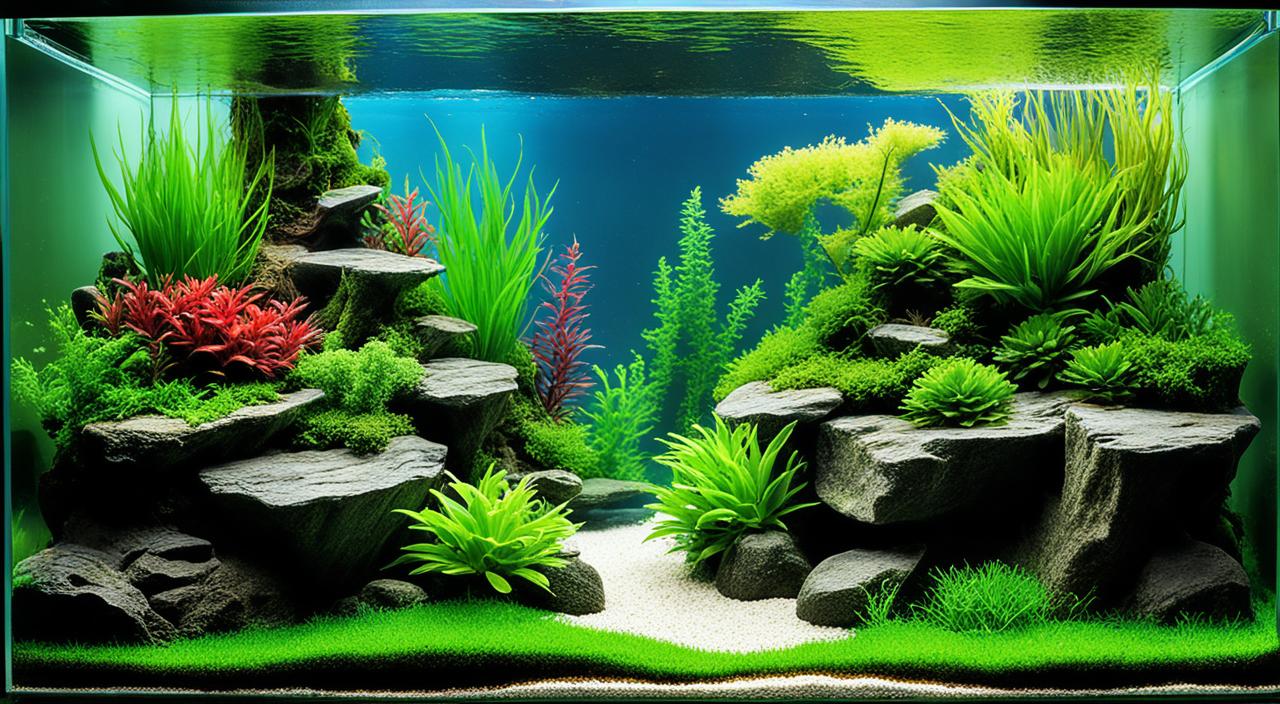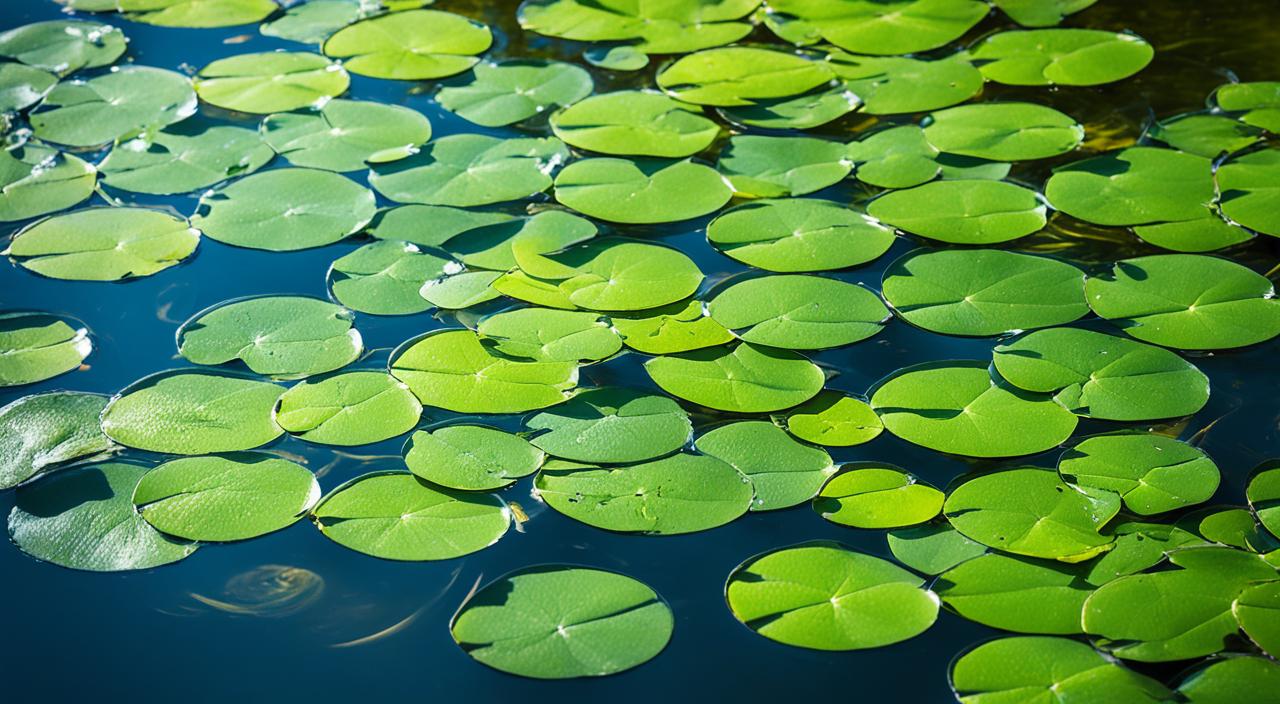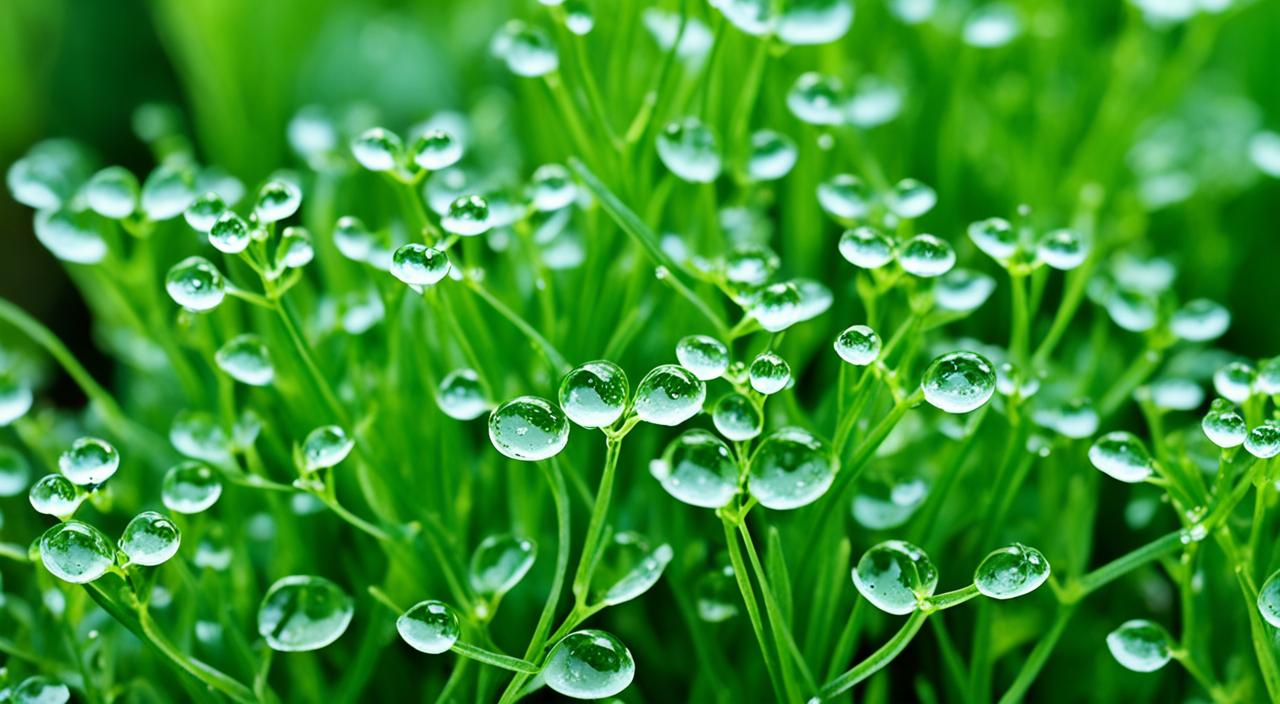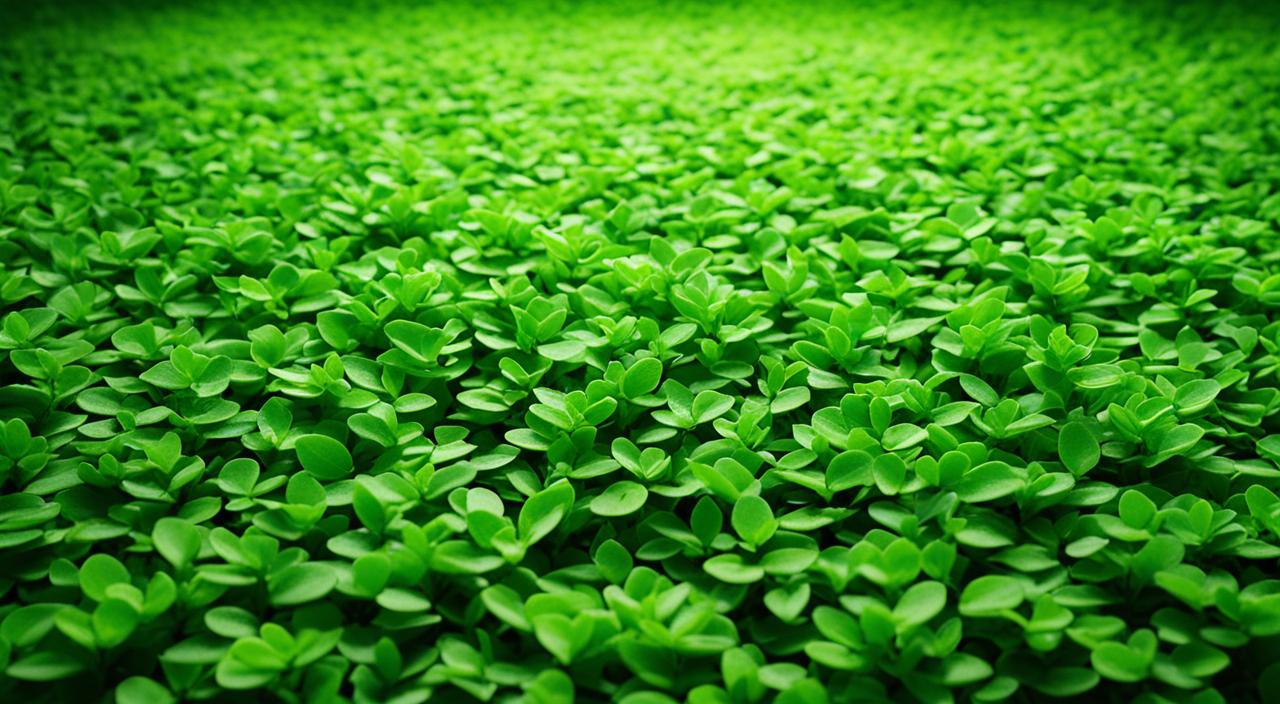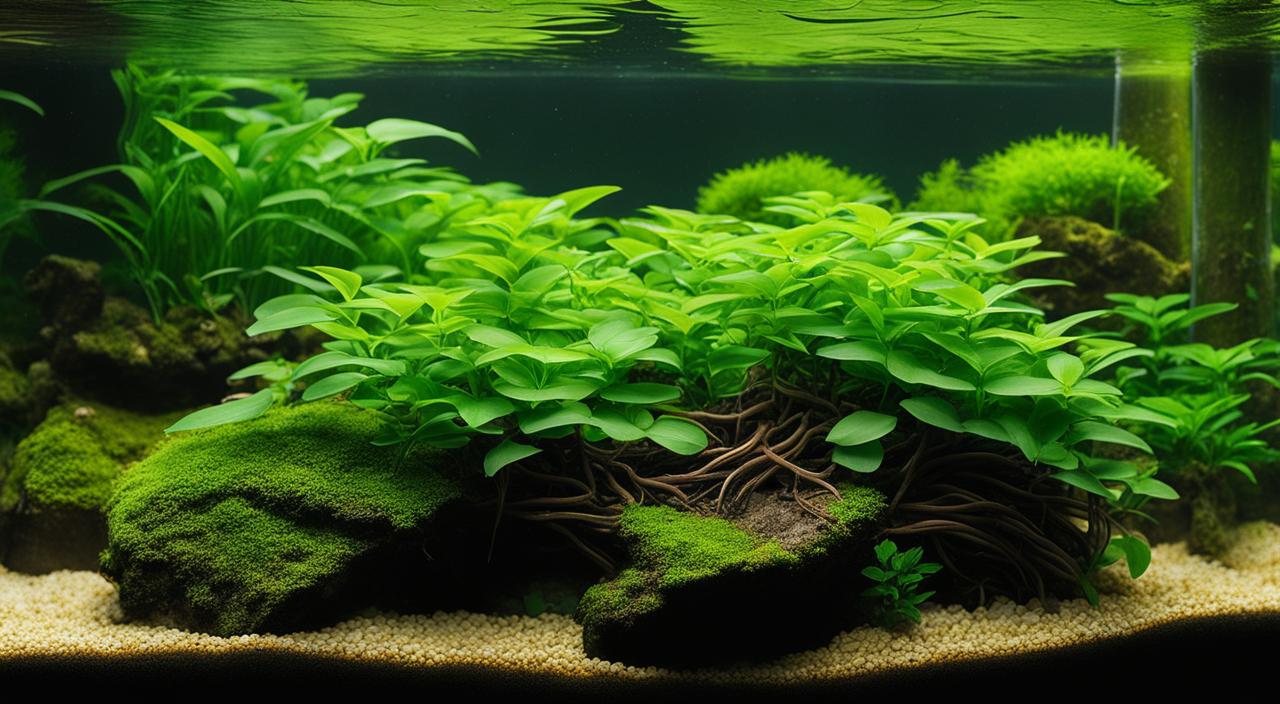Have you ever gazed into an aquarium and felt transported into a serene underwater world? Imagine creating that lush, verdant landscape in your tank. Aquarium Carpeting plants are the key to transforming your aquascape into a breathtaking underwater garden. But where do you start, and how do you choose the right plants to create that perfect aquatic scene?
Key Takeaways:
- Carpeting plants are essential for creating a stunning underwater garden in your aquarium.
- They provide a natural habitat for fish and other aquatic creatures, reduce algae growth, and enhance the tank’s aesthetic appeal.
- Categories of carpeting plants include grass-like plants, mosses, ferns, and related plants.
- Choosing the right carpeting plants involves considering tank size, lighting, and water parameters.
- Proper planting techniques and maintenance are crucial for the long-term health of carpeting plants.
Understanding Aquarium Carpeting Plants
This section will delve deeper into carpeting plants and their significance in aquascaping. As the name suggests, carpeting plants are low-growing plants that spread across the substrate, creating a lush carpet-like appearance in aquariums. They play a crucial role in aquascaping by adding texture, depth, and a naturalistic look to the underwater landscape.
Definition and Role
Carpeting plants are aquatic plants that have adapted to grow horizontally rather than vertically. They have specialized creeping stems or runners that spread horizontally along the substrate, forming a dense mat of foliage. This growth habit allows carpeting plants to create a carpet-like effect in aquariums, mimicking the appearance of lush green meadows or forests.
The role of carpeting plants in aquascaping goes beyond aesthetics. They serve as essential components of a well-balanced aquatic ecosystem, providing numerous benefits to the fish and the overall tank environment.
Benefits of Carpeting Plants
There are several advantages to incorporating carpeting plants into your aquascape:
- Natural Habitat: Carpeting plants create a natural and comfortable habitat for fish, shrimp, and other aquatic creatures. The dense carpet provides hiding places, resting spots, and protection for tiny organisms, promoting their overall well-being.
- Algae Growth Control: Carpeting plants compete with algae for nutrients and light, helping suppress unwanted algae growth in the aquarium. They act as natural filters, absorbing excess nutrients and reducing the resources available for algae to thrive.
- Aesthetic Appeal: The presence of carpeting plants adds visual interest and beauty to the aquarium. The lush green carpet creates a captivating contrast against the hardscape elements, enhancing the overall aesthetics of the aquascape.
- Water Quality and Oxygenation: Carpeting plants play a vital role in maintaining water quality by absorbing toxins and releasing oxygen through photosynthesis. This process helps to oxygenate the water and create a healthy environment for the aquatic inhabitants.
- Erosion Prevention: Carpeting plants’ dense root systems help anchor the substrate and prevent erosion. This is particularly important in areas with strong water flow or for aquariums with active diggers, ensuring the stability of the aquascape layout.
Now that we better understand carpeting plants and their role let’s explore the different categories of carpeting plants in the next section.
Categories of Carpeting Plants
This section will categorize carpeting plants into different types based on their growth patterns and characteristics. This will help you choose the right carpeting plants for your aquascape. Let’s explore the three main categories of carpeting plants: grass-like plants, mosses, ferns, and related plants.
Grass-like Plants
Grass-like carpeting plants add a lush and vibrant look to your aquarium. They have thin, elongated leaves that resemble actual grass. These plants create a dense carpet that covers the substrate, providing a natural and realistic feel to your aquascape. Some popular varieties include Dwarf Hairgrass (Eleocharis parvula), Baby Tears (Hemianthus callitrichoides), and Micro Sword (Lilaeopsis brasiliensis).
These plants typically require high light intensity and nutrient-rich substrate to thrive. They also benefit from regular trimming to maintain their carpet-like appearance. Grass-like carpeting plants create a grassy meadow effect in your aquascape.
Mosses
Mosses are versatile and hardy carpeting plants that add a touch of natural beauty to your aquarium. They are delicate and feathery, creating a soft and inviting carpet effect. Some common mosses used in aquascaping include Java Moss (Taxiphyllum Barbieri), Christmas Moss (Vesicularia Montagne), and Flame Moss (Taxiphyllum sp.), each with its unique growth pattern and texture.
Moss carpeting plants are relatively undemanding and can tolerate various conditions. They can be attached to rocks, driftwood or even left to float freely in the water column. Regular maintenance, such as gentle pruning and debris removal, will help keep mosses healthy and vibrant in your aquascape.
Ferns and Related Plants
Ferns and related carpeting plants offer a different texture and visual appeal than grass-like and moss carpeting plants. These plants have intricate, delicate leaves that create a graceful and captivating carpet effect. Some popular choices for ferns and related carpeting plants include Java Fern (Microsorum pteropus), Pellia (Monosolenium tenerum), and Bolbitis Ferns (Bolbitis heudelotii).
Ferns and related plants are generally low-maintenance and can adapt to various lighting conditions. They can be attached to rocks, driftwood, or even positioned on the substrate. These plants add a touch of elegance and a natural feel to your aquascape, perfect for creating a serene underwater landscape.
Now that we’ve explored the different categories of carpeting plants, you better understand the options available for creating a stunning carpet effect in your aquascape. The next section will discuss the factors to consider when choosing the right carpeting plants for your aquarium.
Choosing the Right Carpeting Plants for Your Aquarium
Choosing the right carpeting plants for your aquarium is crucial for a successful aquascape. Several factors must be considered to ensure your carpet plants’ healthy growth and compatibility with aquarium conditions. This section will explore the key considerations and provide tips for matching the perfect carpeting plants with your aquarium.
Factors to Consider
- Tank Size and Shape: Carpeting plants have different growth habits, and their suitability may vary based on tank size and shape. Consider the available space in your aquarium and choose carpeting plants that will fit and thrive in your setup.
- Lighting and CO2 Requirements: Different carpeting plant species have varying light and CO2 requirements. Some may thrive in low-light conditions, while others may need higher levels of both light and CO2. Evaluate your aquarium’s lighting setup and CO2 injection system, if any, and select carpeting plants that match your current setup or are compatible with any adjustments you are willing to make.
- Water Parameters: Carpeting plants have specific preferences regarding water parameters such as temperature, pH, and hardness. Ensure that the carpeting plants you choose are compatible with your aquarium’s existing water conditions or that you are willing to modify them to meet their needs.
- Aesthetic Effect: Consider the desired aesthetic effect you want to achieve in your aquascape. Some carpeting plants have finer leaves, creating a softer and more delicate look, while others have broader leaves, yielding a denser and more robust appearance. Choose carpeting plants that align with your vision for your aquarium.
Matching Plants with Aquarium Conditions
To ensure their thrive, the carpeting plants you choose must match your specific aquarium conditions. Research and evaluate each species’ requirements and assess how well they align with your tank’s parameters. Consider lighting intensity, CO2 supplementation, water temperature, pH, and hardness to ensure compatibility.
Additionally, consider any other aquatic species cohabiting in your tank. Some carpeting plants may have specific compatibility issues with certain fish or invertebrates due to their grazing or snacking habits. Research the potential interactions between the carpeting plants and your aquarium inhabitants to avoid conflicts.
By carefully considering these factors and matching carpeting plants with your aquarium conditions, you can create a vibrant and healthy carpeted aquascape that brings beauty and life to your underwater world.
Planting and Maintenance
Planting and maintaining carpeting plants in your aquarium is crucial for their overall health and successful growth. This section provides essential techniques and tips to ensure your carpeting plants thrive.
Planting Techniques
Proper planting techniques are essential to create a lush carpet of plants in your aquarium. Here are some basic tips:
- Use high-quality aquasoil or substrate specifically designed for carpeting plants. This will provide the necessary nutrients and anchorage for their roots.
- Consider using tissue culture plants. These plants come in a sterile gel or liquid, free from pests and diseases, ensuring a clean start for your carpet.
- Planting depth and spacing are crucial. Plant your carpeting plants close together to achieve a dense carpet effect. Ensure the roots are securely nestled in the substrate, but avoid burying the leaves to prevent rotting.
These planting techniques will create an ideal environment for your carpeting plants to establish and grow.
Maintenance Tips
Maintaining your carpeting plants is essential to keep them healthy and visually appealing. Here are some maintenance tips to keep in mind:
- Regularly trim the carpeting plants to prevent overgrowth and ensure light penetration to the lower leaves. This will also discourage algae growth.
- Fertilize your aquarium regularly with liquid fertilizers or root tabs to provide essential nutrients for the plant’s growth.
- Monitor water parameters such as temperature, pH, and CO2 levels. Carpeting plants often require higher CO2 levels and bright lighting for optimal growth.
- Regular water changes should be performed to maintain water quality and prevent the buildup of harmful substances hindering plant growth.
Practising these maintenance tips will promote your carpeting plants’ long-term health and vitality and ensure a beautiful and thriving aquascape.
Common Challenges and Solutions
You may encounter several common challenges when cultivating carpeting plants for your aquascape. Understanding these issues and having effective solutions handy can help you overcome obstacles and ensure the long-term success of your carpeting plants. Let’s explore some of the common problems and their corresponding solutions:
Addressing Common Issues
- Algae Growth: Algae can quickly overtake your carpeting plants, restricting their growth and impacting your aquarium’s overall aesthetics. Ensure your tank’s lighting and nutrient levels are appropriately balanced to combat algae growth. Consider adjusting the duration and intensity of light, reducing feeding amounts, and maintaining good water circulation. Additionally, introducing algae-eating organisms, such as shrimp or snails, can help control algae in your aquascape.
- Yellowing or Melting of the Carpet: If your carpeting plants are yellow or melted, it could indicate a nutrient deficiency, improper lighting, or CO2 imbalance. Regular water tests should be conducted to ensure all essential nutrients are present. Adjust your lighting and CO2 levels as needed. Prune and trim any affected plant parts to redirect resources to healthy growth.
- Poor Growth Rate: Slow growth or stunted development of carpeting plants can indicate issues with lighting, CO2 levels, or nutrient availability. Optimize lighting conditions by positioning your aquarium lights appropriately or upgrading to higher-quality bulbs. Ensure adequate CO2 supplementation for optimal plant growth. Consider adding root tabs or liquid fertilizers to provide essential nutrients, and regularly trim and prune your plants to encourage new growth.
Providing Solutions
To resolve these challenges and ensure the well-being of your carpeting plants, try the following solutions:
- Optimize Light and CO2: Adjust your aquarium lighting and CO2 supplementation to meet the specific needs of your carpeting plants. Ensure adequate light intensity and duration, as well as consistent CO2 levels, to promote healthy growth.
- Maintain Nutrient Balance: Regularly test your water parameters and address nutrient deficiencies. Use fertilizers or root tabs to supply essential nutrients to your carpeting plants. Be mindful of the nutrient requirements of different plant species and adjust accordingly.
- Manage Tank Conditions: Proper water circulation and filtration prevent excess nutrients and debris accumulation. Regular water changes can help maintain stable water parameters and reduce the risk of algae growth. The feeding schedule and quantities must also be observed and adjusted to prevent excessive food waste in the tank.
- Prune and Trim Regularly: Trim and prune your carpeting plants to remove any decaying or dying portions. This encourages new growth and prevents the spread of algae or diseases. Proper maintenance and care will help your carpeting plants flourish.
Implementing these solutions and troubleshooting tips can help you overcome common challenges associated with carpeting plants. You can enjoy a vibrant and lush carpet in your aquascape by promptly maintaining a balanced environment and addressing issues. With proper care and attention, your carpeting plants will thrive and provide your aquarium with a beautiful and natural element.
Featured Aquascapes Using Carpeting Plants
This section will showcase various aquascapes that beautifully incorporate carpeting plants. These stunning aquarium setups enhance the aesthetic appeal of any aquatic environment and provide a natural and vibrant habitat for fish and other marine creatures. Let’s explore some inspiring examples that will ignite your creativity and help you design your own breathtaking carpeting plant aquascapes.
Design and Plant Choices
Creating a visually appealing carpeting plant aquascape involves careful design considerations. Choosing carpeting plants is crucial in achieving the desired effect. Some popular carpeting plant options include Glossostigma elatinoides, Hemianthus callitrichoides, Eleocharis parvula, Marsilea hirsuta, Micranthemum ‘Monte Carlo’, and Staurogyne repens.
When designing your carpeting plant aquascape, consider the tank’s size, lighting requirements, water parameters, and desired aesthetic. Experimenting with different plant combinations, creating varied textures, and utilizing hardscape elements like rocks or driftwood can further enhance the visual impact of your aquascape.
Resources and Further Reading
For aquascapers looking to expand their knowledge and find more information about carpeting plants, there are a variety of resources and further reading materials available. These resources provide detailed guides on individual carpeting plant species, helping aquascapers better understand their care and maintenance requirements.
One valuable resource for in-depth plant information is detailed posts or articles that focus specifically on individual carpeting plant species. These guides provide comprehensive insights into each plant’s characteristics, growth patterns, and care tips, allowing aquascapers to make informed decisions and successfully incorporate them into their aquascapes.
In addition to specific plant guides, recommended resources offer a wealth of information for aquascaping enthusiasts. Books, websites, and online communities dedicated to aquatic plants and aquascaping can provide knowledge and inspiration for aquascapers. These resources often feature expert advice, step-by-step tutorials, and stunning photographs of successful carpeting plant setups.
By exploring these resources and engaging with the aquascaping community, aquascapers can continue to enhance their skills, learn new techniques, and find inspiration for their carpeting plant aquascapes.
Conclusion
After exploring the world of carpeting plants for aquascaping, we can conclude that these plants offer numerous benefits for aquarium enthusiasts. Throughout this guide, we have discussed the definition and role of carpeting plants, the various categories available, and factors to consider when choosing the right plants for your aquarium. We have also provided insights into planting techniques, maintenance tips, and solutions for everyday challenges that may arise.
Carpeting plants enhance the aesthetic appeal of your aquarium and provide a natural habitat for fish and other aquatic creatures. They help reduce algae growth and improve the ecosystem’s health and balance. Aquascapers have endless opportunities to create stunning underwater landscapes with many carpeting plant options.
As you embark on your carpeting plant journey, remember to consider your aquarium’s specific requirements and tailor your plant choices accordingly. Regular maintenance, including trimming and fertilization, will ensure your carpeting plants’ long-term health and vibrancy.
We hope this guide has inspired and motivated you to explore the world of carpeting plants for aquascaping. The possibilities are limitless, and with careful planning and creativity, you can create a breathtaking underwater scene that will captivate the eyes and soothe the senses.
Remember to share your experiences and engage with the aquascaping community, as they can provide valuable insights and support on your journey. It’s time to dive into the exciting world of carpeting plants and discover the wonders they can bring to your aquarium.
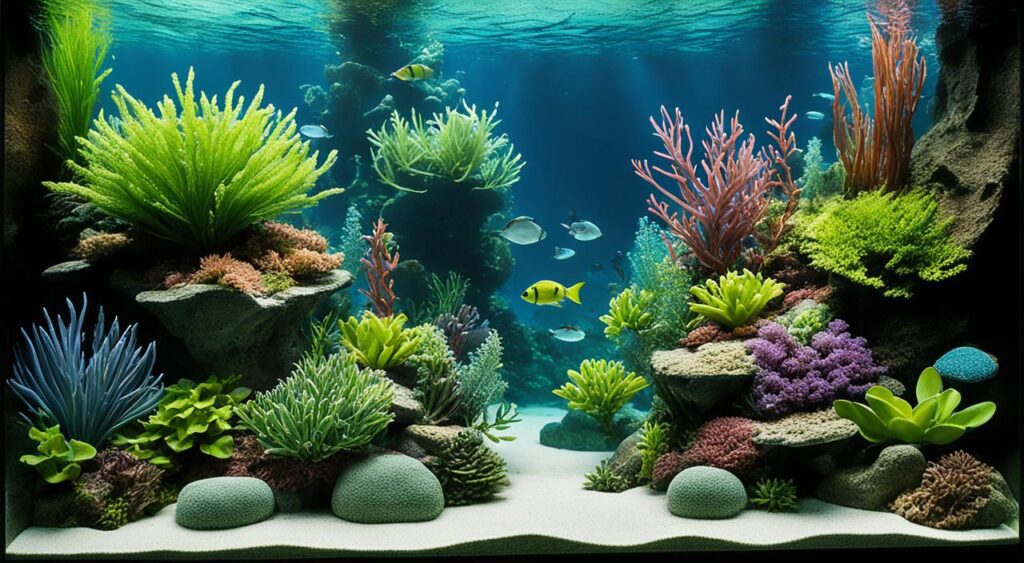
Next Steps
Now that you have learned all about carpeting plants for aquascaping, it’s time to join the vibrant and passionate aquascaping community. By engaging with fellow aquarium enthusiasts, you can share your experiences, learn from others, and inspire one another to create stunning underwater landscapes.
We invite you to participate and contribute to the aquascaping community by sharing your own aquascaping experiences, asking questions, and showcasing photos of your carpeting plant setups whether a beginner or an experienced hobbyist, your unique perspective and insights are valuable to the community.
We recommend joining social media groups, forums, and online communities dedicated to aquascaping to get started. These platforms allow like-minded individuals to connect, share ideas, and offer support. Some popular options include Facebook groups like “Aquascaping Enthusiasts” and forums like “The Planted Tank Forum.”
Remember, the aquascaping community is a welcoming and inclusive space where everyone can learn and grow together. So don’t hesitate to join, connect with fellow enthusiasts, and let your passion for aquascaping flourish!
FAQ
What are carpeting plants?
What are the benefits of using carpeting plants in aquascaping?
What are the different categories of carpeting plants?
How do I choose the right carpeting plants for my aquarium?
What are the proper planting and maintenance techniques for carpeting plants?
What are the common challenges with carpeting plants, and how do I overcome them?
Can you provide examples of aquascapes that feature carpeting plants?
Where can I find more resources and further reading on carpeting plants?
Can you summarize the key points of this guide on carpeting plants for aquascaping?
How can I interact with the aquascaping community and share my own experiences?
Source Links
- https://buceplant.com/blogs/aquascaping-guides-and-tips/everything-you-need-to-know-about-carpeting-aquarium-plants-shrimpery
- https://buceplant.com/blogs/aquascaping-guides-and-tips/how-to-properly-grow-aquarium-carpet-plants
- https://www.2hraquarist.com/blogs/freshwater-aquarium-plants-guide/carpeting-plants

